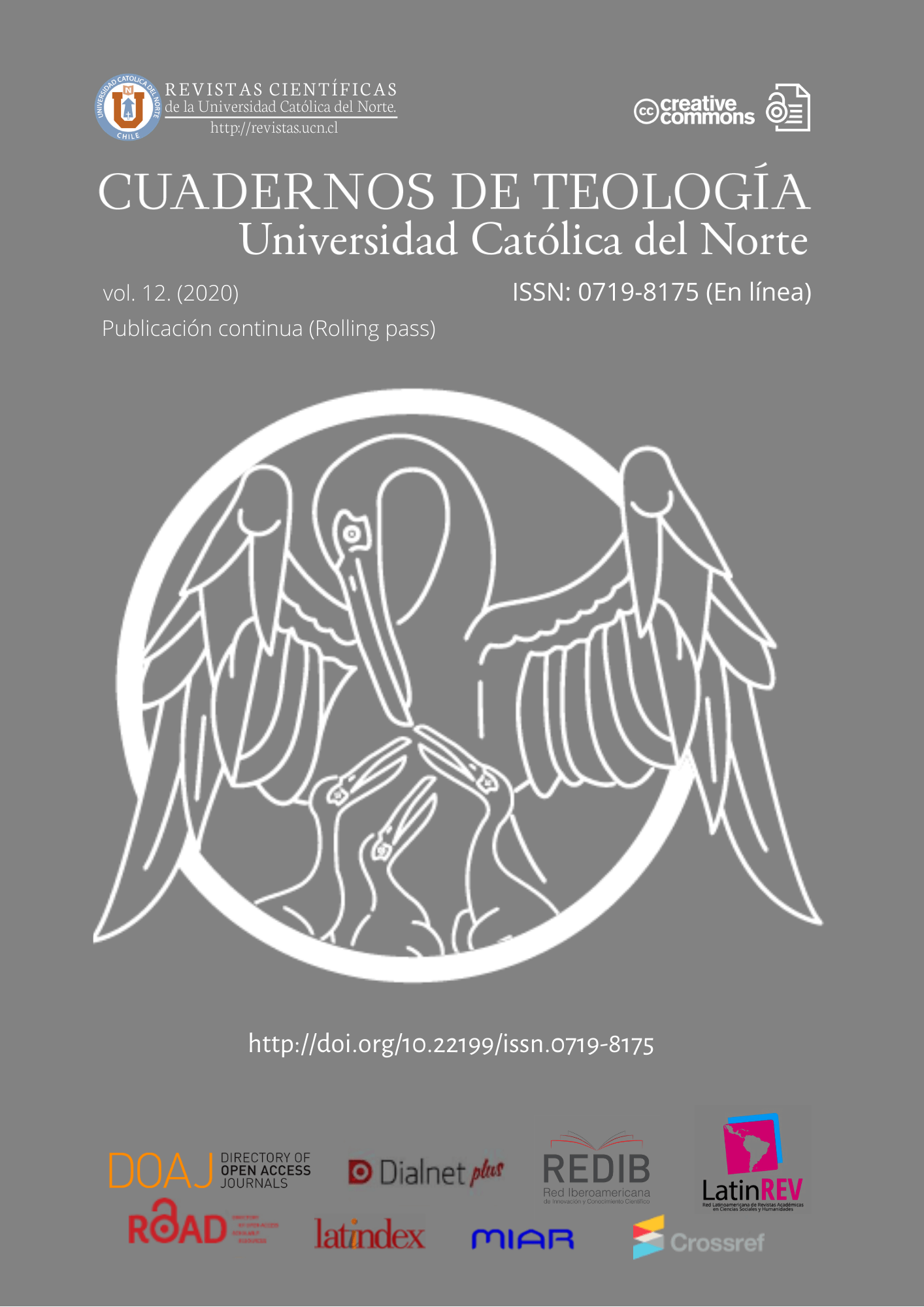The image of the human being and specially of the woman in Gertrud von Le Fort
DOI:
https://doi.org/10.22199/issn.0719-8175-2020-0005Keywords:
Literary anthropology, Woman, Solidary Personalism, German catholic writers of the 20th centuryAbstract
The main novels are analyzed: The veil of Veronica (1928), The Song at the Scaffold (1931) and The Wreath of the Angels (1946) of the catholic german writer, poet and essayist Gertrud von Le Fort (1876-1971) and her essay The eternal woman (1934). According to Le Fort, the human being is characterized as an insecure (at the level of life, knowledge and religion), free (specially in his decision between god and the devil), worthy (with her rights) and spiritual (he has a soul open to god) person. On the same time as she defends decisively the individual, Le Fort emphasizes, on the other side, his social being, obtaining her greatest literary performance in the description of profound human meetings. The human community consists according to Le Fort in being the one in the other (cf. aspect of spiritual unity), with the other (cf. solidarious activity]) and for the other (cf. vicarious collaboration in the salvation). This ideal generally is lived in a better form on part of the woman as virgin, wife and mother with her great capacity of devotion, whose model is the Virgin Mary with her ‘fiat’. In this way, Le Fort revels her belonging to a solidarious personalism which she shares with other catholic phenomelogical philosophers like Edith Stein, Max Scheler and Dietrich von Hildebrand.
References
Bach, H. (Ed.). (1976). Dichtung ist eine Form der Liebe: Begegnung mit Gertrud von le Fort und ihrem Werk: Zum 100. Geburtstag am 11. Oktober 1976. München: Ehrenwirth.
Blanch i Xiró, A. (2002). El espíritu de la letra: acercamiento creyente a la literatura. Madrid: PPC.
Blanch i Xiró, A. (1996). El hombre imaginario: una antropología literaria (2a ed.). Madrid: PPC.
Beller, M. (1984). Tematología. En M. Schmeling (Ed.) e I. Torres Corredor (Trad.), Teoría y praxis de la literatura comparada (pp. 101-133). Barcelona: Alfa.
Bergs, E. (1948). Das Menschenbild der Gertrud von le Fort und die christliche Mystik (Doktorarbeit). Universität Bonn.
Biser, E. (1980). Überredung zur Liebe: die dichterische daseinsdeutung Gertrud von le Forts. Regensburg: Habbel.
Blume Sánchez, J. y Franken Kurzen, C. (2006) La crítica literaria del siglo XX. 50 modelos y su aplicación. Santiago: Ediciones Pontificia Universidad Católica.
Bruggisser, H. (1959). Gertrud von le Fort: das dichterische Werk. (Doktorarbeit). Universität Zürich.
Burggraf, J. (1988). Maria als Vorbild für die Frau. Das Marienbild bei Gertrud von le Fort. En L. Bossle & J. Pottier (Eds.), Christliche Literatur im Aufbruch: Im Zeichen Gertrud von le Forts. (pp. 62-72). Würzburg: Creator.
Duelli, E. (1954). Das Problem des Bösen im Werk der Gertrud von le Fort. (Doktorarbeit). Universität Freiburg im Breisgau
Focke, A. (1960). Gertrud von le Fort. Gesamtschau und Grundlagen ihrer Dichtung. Graz: Verlag Styria.
Franken, C. A. (2019). La literatura debe estremecer el corazón: la forma de pensar y la imagen del poeta, del mundo y del hombre en Gertrud von le Fort. Buenos Aires: Ágape Libros.
Frühwald, W. (1976). Deutscher ʻrenouveau catholique. Zur literarischen Einordnung des Werkes Gertrud von le Forts”. En: H. Bach (Ed.), Dichtung ist eine Form der Liebe. Begegnung mit Gertrud von le Fort. Zum 100. Gebürtstag am 11. Oktober 1976 (pp. 60-73). München: Ehrenwirth.
Jappe, H. (1950). Gertrud von le Fort : das erzählende Werk. Meran: Unterberger.
Juan Pablo II. Vaticano II. Familiaris Consortio. 22 de noviembre de 1981. https://bit.ly/2JNI1hp
Kienecker, F. (1988). Blinkzeichnen vom Hochsitz der Heiligen? (Gertrud von le Fort am Ende des Jahrhunderts). En L. Bossle & J. Pottier (Eds.), Christliche Literatur im Aufbruch: Im Zeichen Gertrud von le Forts. (pp.110-122). Würzburg: Creator.
Le Fort, G. (1950). Werk und Bedeutung. ʻDer Kranz der Engelʼ im Widerstreit der Meinungen. München: Ehrenwirth.
Le Fort, G. (1958). Aufzeichnungen und Erinnerungen. Einsiedeln: Benziger.
Le Fort, G. (1963). La corona de los ángeles. M. R. Font Playá (Trad.). Barcelona: Destino.
Le Fort, G. (1965). La mujer eterna (3a ed.) (M. C. Aguilera, Trad.). Madrid: Rialp.
Le Fort, G. (1966). Die Erzählungen. Wiesbaden: Herder-Buchgemeinde.
Le Fort, G. (1966b). El velo de Verónica (3a ed.) (J. M. Souviron, Trad.). Santiago: Zig-Zag.
Le Fort, G. (1997). La última en el cadalso. (A. L. A., Trad.). Santiago: Andrés Bello.
Meyerhofer, N. J. (1993). Getrud von le Fort. Berlín: Morgenbuch.
Pfleger, K. (1959). Kundschafter der Existenztiefe. Frankfurt am Main: Josef Knecht, 1959.
Pottier, J. (1988). Gertrud von le Fort: Sängerin der Kirche – Kundschafterin an den Grenzen der Glaubenswelt. En L. Bossle & J. Pottier (Eds.), Christliche Literatur im Aufbruch: Im Zeichen Gertrud von le Forts (pp. 123-148). München: Ehrenwirth.
Remak, H. R. (1998). La Literatura comparada: definición y función. En M. J. Vega y N. Carbonell (Eds.), La literatura comparada: principios y métodos (pp. 89-99). Madrid: Gredos.
Rohrmoser, G. (1988), Verlust der grossen Utopie. Ethik in der Überlebenskrise der wissenschaftlich-technischen Zivilisation. Mut, 253, 55-65.
Rombach, H. (1980). Phänomenologie des gegenwärtigen Bewusstseins. München: Karl Alber.
Scheler, M. (1954). Der Formalismus in der Ethik und die materiale Wertethik: Neuer Versuch der Grundlegung eines ethischen Personalismus (4a ed., Vol. 2, Gesammelte Werke). Bern.
Scheler, M. (1968). Die christliche Liebesidee und die gegenwärtige Welt. En su Von Ewigen im Menschen (5a ed., Vol. 5, Gesammelte Werke, pp. 335-401). München: Francke Verlag.
Schlosser, H. (1971). Der neue Mensch, die neue Gesellschaftsordnung. Vallendar: Schönstatt.
Schmalenberg, E. (1956). Das erzählerische Werk Gertrud von le Forts. (Dissertation). Marburgo.
Schneider, R. (1946). Das Erbe im Feuer: Betrachtungen und Rufe. Freiburg im Breisgau: Herder
Stein, E. (2003). Individuo y comunidad. En su Escritos filosóficos: etapa fenomenológica (Vol. 2, Obras completas, pp. 343-520). Burgos: Monte Carmelo.
Stein, E. (2003b). La estructura de la persona humana y su problemática cognoscitiva. En su Escritos antropológicos y pedagógicos (Vol. 4, Obras completas, pp. 555-740). Burgos: Monte Carmelo.
Wolff, P. (1935). Vom Sinn der Ehrfurcht (Doktorarbeit). Universität Bonn.
Wust, P. (1946). Ungewissheit und Wagnis (4a. ed). München: Im Koesel Verlag.
Published
How to Cite
Issue
Section
Copyright (c) 2020 Clemens Franken Kurzen

This work is licensed under a Creative Commons Attribution 4.0 International License.
Los autores continúan como propietarios de sus trabajos, y pueden volver a publicar sus artículos en otro medio sin tener que solicitar autorización, siempre y cuando indiquen que el trabajo fue publicado originariamente en Revista Cuadernos de Teología (eISSN:0719-8175).












_(1).png)






